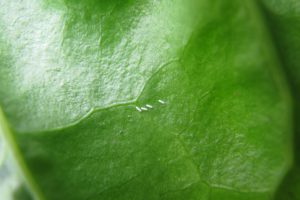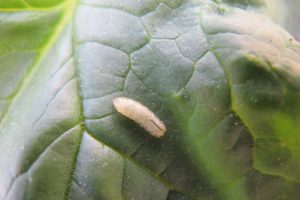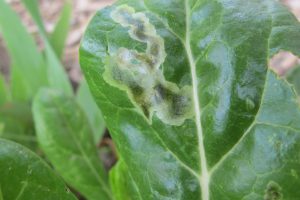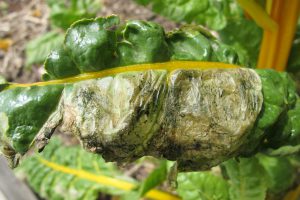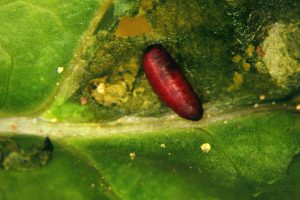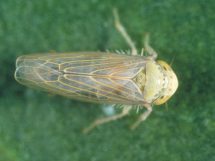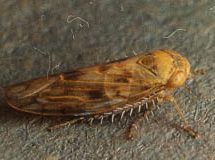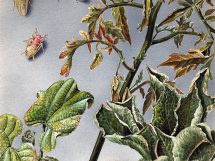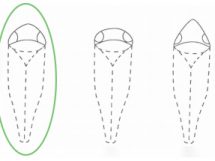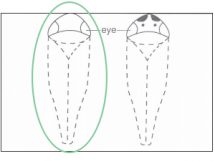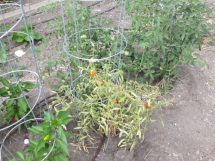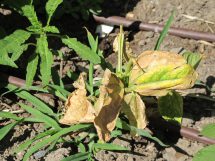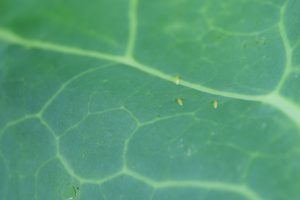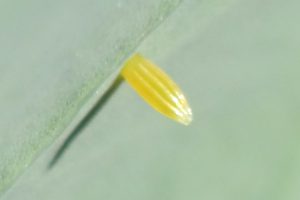In this Issue:
- Leafminers: are actively feeding on edible greens
- Beet leafhopper: preventative measures for curly top virus
- Cabbage White Butterfly/Imported Cabbageworm: adults fluttering above vegetable crops
Leafminers
Leafminers have been spotted feeding through “mines” of dead leaf tissue. Leafminers will feed on the leaves of bean, eggplant, pepper, potato, squash, tomato, watermelon, cucumber, beet, pea, lettuce and many other plants.
Leafminer damage has little impact on plant growth but can be quite destructive to vegetables grown for edible greens.
MANAGEMENT
Regularly check young seedlings for leaf mines. Most mines occur on cotyledons and the first true leaves. It is not necessary to treat leafminers that are feeding on leaves of root crops such as beets, where the edible portion is not affected. However, leafminers on spinach or leafy greens may require management.
CULTURAL
- Inspect leaves for egg masses throughout the growing season and crush them.
- Clip and remove infested leaves.
- Gently cultivate the soil around the plants to uncover pupae and destroy any that are found.
- Use adequate irrigation to keep plants healthy.
- Eliminate alternate hosts. Destroy weeds and deep plow or physically remove crop residues which can be food and overwintering sources for leafminers.
- Encourage parasitic wasps by planting flowering plants with nectar and pollen-rich umbel-type flowers with shallow cups, such as yarrow, dill, and fennel.
- Cultivate the soil in late fall to expose overwintering pupae to the colder temperatures that will kill them.
(Click images to enlarge)
CHEMICAL
Insecticide applications help prevent adults from laying eggs, but they do not kill larvae that are already feeding within the plant leaves. Choose low impact insecticides such as spinosad, when possible to reduce impacts on natural enemies. If insecticides are necessary, the time to treat is on the eggs as they hatch. Make sure to get good coverage on the leaves.
BIOLOGICAL
Generally, leafminer numbers are strongly suppressed by natural predators and outbreaks are usually associated with the use of insecticides. Several parasitic wasps and predators, including vespid wasps (yellow jacket and European paper wasp), will attack leafminers.
MORE INFORMATION
- UMN Extension, Leafminers in Home Vegetable Gardens
- PSU Extension, Control Spinach Leafminer at the Time of Planting
Beet Leafhopper
Remember the curly top virus last year (see page 8) that infected tomato plants throughout the state? With the unpredictable nature of beet leafhoppers, it is hard to say if this year will be better, worse, or the same.
(Click images to enlarge)
Beet curly top virus has several hosts including beets, tomato, pepper, potato, bean, swiss chard, cucurbits, and weeds such as Russian thistle and weedy mustards. Curly top is challenging to manage and control methods may be inadequate in years with high pest pressure. But here are some options for prevention and here’s to hoping it is a low pest pressure year.
- Rogue out infected plants immediately upon detection.
- Exclude leafhopper with floating row cover.
- Destroy and remove plant debris.
- For tomatoes, plant resistant varieties (‘Rowpac’, ‘Roza’, ‘Salad Master’, and ‘Columbian’).
- Use dense plant spacing.
- Shade plants.
- Intercrop or ‘hide’ susceptible hosts among non-susceptible plants.
More information on curly top virus and beet leafhoppers:
- Severe Curly Top Virus in 2016 Vegetable Crops (see page 8) Utah Pests News
- Beet leafhopper, Utah Vegetable Production and Pest Management Guide
- Controlling Curly Top Virus of Tomato, USU Extension
- Beet Curly Top Virus, Utah Vegetable Production and Pest Management Guide
Cabbage White Butterfly / Imported Cabbageworm
Cabbage white butterfly adults have been seen fluttering above vegetable gardens in Utah. The cabbage white butterfly, also known as the imported cabbage worm, is a caterpillar pest that feeds on all cole crops but prefers broccoli, cabbage, and cauliflower. The adult stage is a white to yellow colored butterfly with one to two black dots on its wings. It is active during the day and is commonly seen flying around vegetable crops during the growing season.
Injury to crops occurs as the caterpillar larvae chew holes in leaves. They may occasionally cause serious defoliation. Initially, feeding is concentrated on outer leaves, but as the caterpillars mature, their feeding intensifies, and they often move into the developing heads, creating tunnels. Contamination of leaves and heads with larval bodies and frass (fecal material) lowers production quality.
(Click images to enlarge)
Management
- Interplant. When brassica crops are interplanted with unrelated plants, larval populations tend to be lower and larval parasitism and predation by beneficial wasps increases.
- Start with clean transplants. Inspect transplants carefully to ensure they are free of caterpillar eggs and larvae.
- Use row covers to prevent adults from laying eggs. Place row covers over plants, or over metal hoops for support, just after planting or transplanting. Ensure that the edges of the row cover are securely buried in the soil along the crop row.
- Handpick and destroy larvae.
- Remove plant debris at the end of the growing season to eliminate overwintering sites.
Diamondback moth and cabbage looper are two other caterpillar pests of brassicas that can be managed in the same way as cabbage white butterfly.
For more information, see our recently published fact sheet on Caterpillar Pests of Brassica Vegetables.

